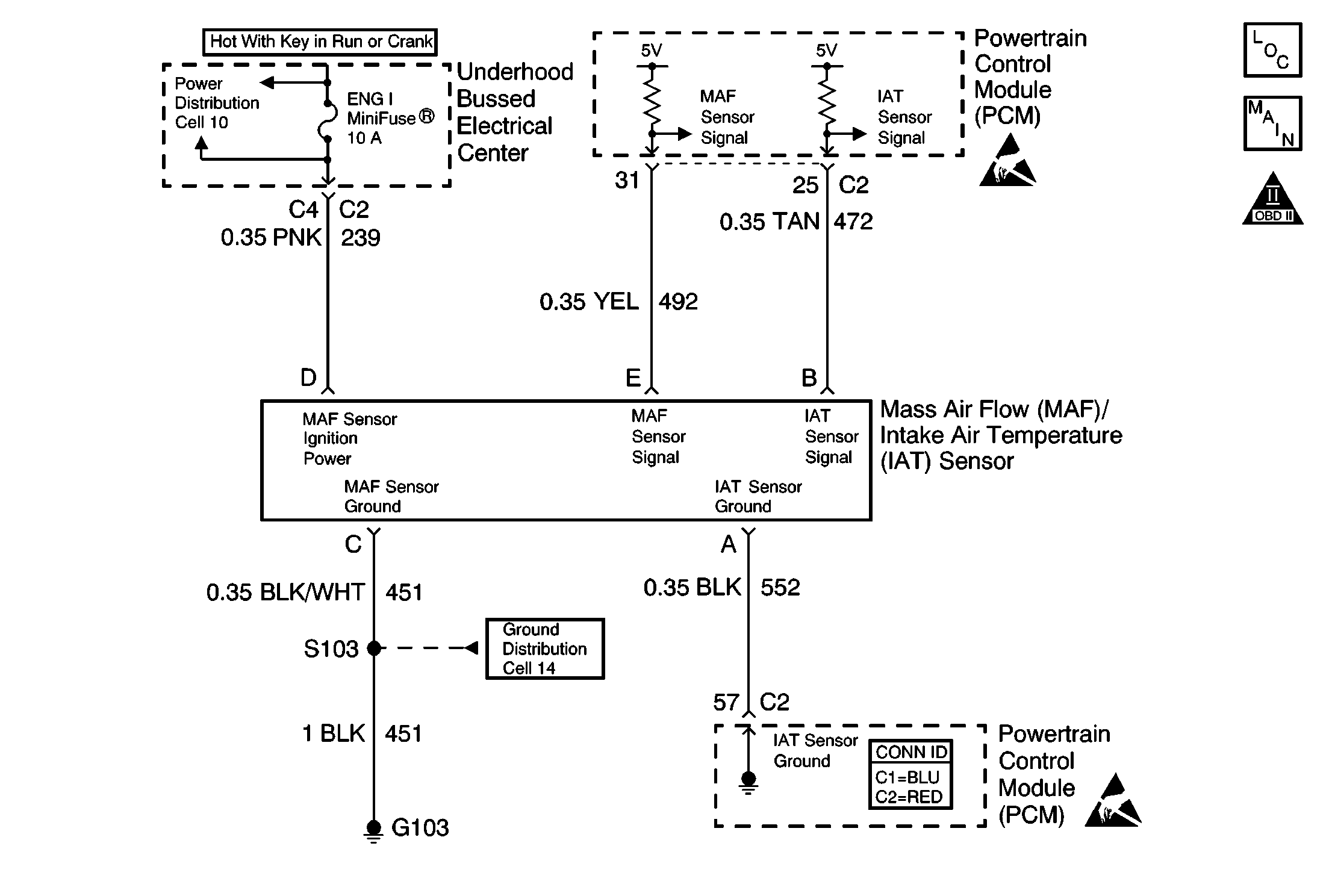
Circuit Description
The intake air temperature (IAT) sensor contains a semiconductor device, a thermistor, which changes the resistance based on the temperature. The IAT sensor is located within the mass air flow (MAF) sensor. The IAT sensor has a signal circuit and a ground circuit. The powertrain control module (PCM) applies 5.0 volts on the signal circuit to the sensor. The PCM monitors the changes in this voltage caused by changes in the resistance of the sensor in order to determine intake air temperature.
When the intake air is cold, the sensor or thermistor resistance is high. The PCM signal voltage only pulls down a small amount through the sensor to a ground. Therefore, the PCM senses a high signal voltage or low temperature. When the intake air is warm, the sensor resistance is low. The signal voltage pulls down a large amount. Therefore, the PCM senses a low signal voltage, or a high temperature.
When the PCM senses a signal voltage lower than the normal operating range of the sensor, this DTC sets.
Intake AirTemperature | Thermistor Resistance | Signal Voltage |
|---|---|---|
Cold | High | High |
Warm | Low | Low |
Conditions for Running the DTC
| • | DTCs P0102, P0103, P0117, P0118, P0500, P0502, P0503 are not set. |
| • | The engine run time is more than 30 seconds. |
| • | The vehicle speed is more than 40 km/h (25 mph). |
Conditions for Setting the DTC
| • | The intake air temperature (IAT) is more than 139°C (282°F). |
| • | The intermittent condition exists for a total of 1.0 second during a 20.0 second time period. |
Action Taken When the DTC Sets
| • | The powertrain control module (PCM) stores the DTC information into memory when the diagnostic runs and fails. |
| • | The malfunction indicator lamp (MIL) will not illuminate. |
| • | The PCM records the operating conditions at the time the diagnostic fails. The PCM stores this information in the Failure Records. |
Conditions for Clearing the DTC
| • | A last test failed, or current DTC, clears when the diagnostic runs and does not fail. |
| • | A history DTC will clear after 40 consecutive warm-up cycles, if no failures are reported by this or any other non-emission related diagnostic. |
| • | Use a scan tool in order to clear the DTC. |
Diagnostic Aids
Important: Remove any debris from the PCM connector surfaces before servicing the PCM. Inspect the PCM connector gaskets when diagnosing or replacing the PCM. Ensure that the gaskets are installed correctly. The gaskets prevent water intrusion into the PCM.
If the engine sat overnight, the engine coolant temperature and intake air temperature values should display within a few degrees of each other. If the temperatures are not within 3°C (5°F), refer to Temperature Versus Resistance .
For an intermittent, refer to Symptoms .
Test Description
The numbers below refer to the step numbers on the diagnostic table.
-
If DTC P0112 failed this ignition, this indicates a hard failure is present. When a hard failure is present, both the hard and intermittent DTCs set.
For any test that requires probing the PCM or component harness connectors, use the connector test adapter kit . Using this kit prevents any damage to the harness connector terminals.
-
Inspects for proper connections.
-
Inspects the wiring harness.
-
Using the Freeze Frame and Failure Records data may aid in locating an intermittent condition. If you cannot duplicate the DTC, the information included in the Freeze Frame and Failure Records data can help determine how many miles since the DTC set. The Fail Counter and Pass Counter can also help determine how many ignition cycles the diagnostic reported a pass or a fail. Operate the vehicle within the same Freeze Frame conditions, such as RPM, load, vehicle speed, temperature etc., that you observed. This will isolate when the DTC failed.
Step | Action | Value(s) | Yes | No |
|---|---|---|---|---|
1 | Did you perform the Powertrain On-Board Diagnostic (OBD) System Check? | -- | ||
Is DTC P0112 also set? | -- | Go to DTC P0112 Intake Air Temperature (IAT) Sensor Circuit Low Voltage | ||
Does the sensor value change abruptly while a related connector is being moved? | -- | |||
Observe the affected sensor value on a scan tool while moving the related wiring harnesses. Does the sensor value change abruptly while moving the related electrical harnesses? | -- | |||
Does the scan tool indicate that this diagnostic failed this ignition? | -- | Go to Diagnostic Aids | ||
6 | Repair the damaged connectors and terminals. Refer to Connector Repairs in Wiring Systems. Is the action complete? | -- | -- | |
7 | Repair the circuit as necessary. Refer to Wiring Repairs in Wiring Systems. Is the action complete? | -- | -- | |
8 |
Is the action complete? | -- | -- | |
9 |
Does the scan tool indicate that this test ran and passed? | -- | ||
10 | Select the Capture Info option and the Review Info option using the scan tool. Does the scan tool display any DTCs that you have not diagnosed? | -- | Go to the applicable DTC table | System OK |
